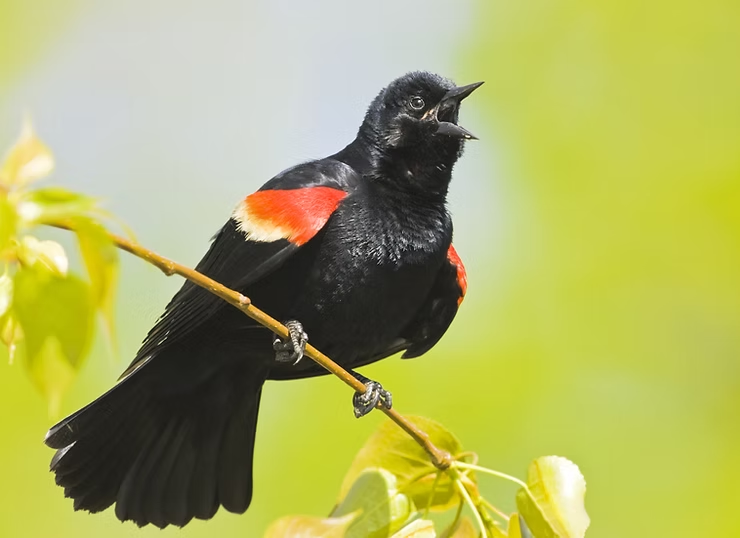Learn to speak the red-winged blackbird's language
- Willy's Wilderness
- May 9, 2022
- 4 min read
Updated: Jul 24
Known for their song and aggressive behaviors, red-winged blackbirds are one of the easiest birds to identify in Will County. It’s all in the name: shiny black feathers with a flash of red and yellow on their shoulders. But those colors do more than help us see them. They help the birds “talk,” sending important messages to friends and foes!

What did you say?
The males use their bright shoulder colors, tails and flight to communicate with everyone around them, and you can learn their signals. But before we get started, you need to know that the red and yellow patches on their shoulders are called epaulets. Think of it as another word for decoration.
Song spread display

The look: Sitting on a twig or reed with his epaulets puffed out and shoulders hunched forward. The tail is lowered and fanned out.
The message: “Keep out of my territory, other male red-winged black birds! All females welcome!”
Naturalist’s notes: Epaulets grow brighter and more vivid, while the black becomes shinier with age. Older males get the best territories and the best mates. Scientists set up an experiment to test the importance of these colors by blackening out the epaulets. In the experiment, the birds without the bright red and yellow lost territory.
Flight display

The look: Flying through the sky, he puffs up his body feathers, especially the red and yellow epaulets. He spreads and lowers his tail feathers. He beats his wings slowly and deeply to fly very slowly.
The message: “I’m patrolling my territory. Get out males! Welcome females!”
Naturalist’s notes: You will usually only see this flight over a male red-winged blackbird’s own territory.
Resting on territory

The look: Perches on a cattail in his territory, usually showing the red and yellow.
The message: “I’m just hanging out . . . in my territory.”
Naturalist’s notes: What if a male is perched outside their territory? Then they show less color.
Feeding

The look: He hides his epaulets when flocking on neutral territory to eat, either in a field or at a bird feeder. There might only be a thin line of yellow peeking through.
The message: “I come in peace! I’m just eating, not causing any problems.”
Naturalist’s notes: They like insects in the summer and seeds in the winter. Sunflower seeds are a great way to lure them to your backyard feeder.
Chasing

The look: He flies above and behind a bird of prey. He makes sure to stay far out of the claws and beak range.
The message: “You might be bigger than me, but I’m not scared. Get out and don’t come back!”
Naturalist’s notes: Often there are several smaller birds that drive out larger predators like crows and hawks. This kind of behavior is called mobbing. This is a great way to see birds.
What about females?

Females look very different. They are streaky brown and sometimes have white eyebrows. (Birders call eyebrows supercilium.) Often people see females at a bird feeder and think they are a totally different species!
She uses body language, too. She might pose in a “song spread” display to other females early in the breeding season. Scientists think this might be to defend her place within a territory. She will also “wing flap” when something disturbs her nest. It can mean “Get outta here!” when she is close to her nest or it can be used to draw the eye further away from her offspring.
That’s MY space!
Red-winged blackbirds are incredibly territorial during nesting season. Males stake out their ground in spring. They like marshes or fields and meadows with plenty of grasses like cattails and sedges. They protect their area from other males and intruders, hoping to attract females. In fact, they might spend more than a third of their day defending their territory. Imagine spending hours of your day on guard! They are even known to go after much larger animals like horses or people.
Words to know
Epaulet: An ornamental shoulder piece.
Supercilium: A stripe that runs from the base of a bird’s beak above its eye.
Once a female picks a mate with the best territory, she hangs out low to the ground or just above the water. Because of her coloring, she blends in perfectly. What is she doing? Gathering nest supplies and hunting for food. Anchored to plant stalks, she weaves a nest out of grasses and bark strips. The cup is lined with dried grasses — perfect for an egg or two. There might be up to 15 females in one territory.
Red-winged blackbirds’ defensive ways sometimes help other birds. Yellow warblers are not a threat, so they are allowed to nest safely in red-winged blackbirds’ territories. This means that yellow warblers are protected from brown-headed cowbirds and other dangers.
Sing me a song
Red-winged blackbirds don’t only communicate with their epaulets. They are well known for their song. Males call out “conk-la-ree,” and females might respond with a short “check-check-check.” Still not sure you know what they sound like? Take a listen.
Now go outside and look for red-winged blackbirds. Can you identify both females and males? What are they saying with their body language? Can you hear their call in the wild? You will be a red-winged blackbird expert in no time!


